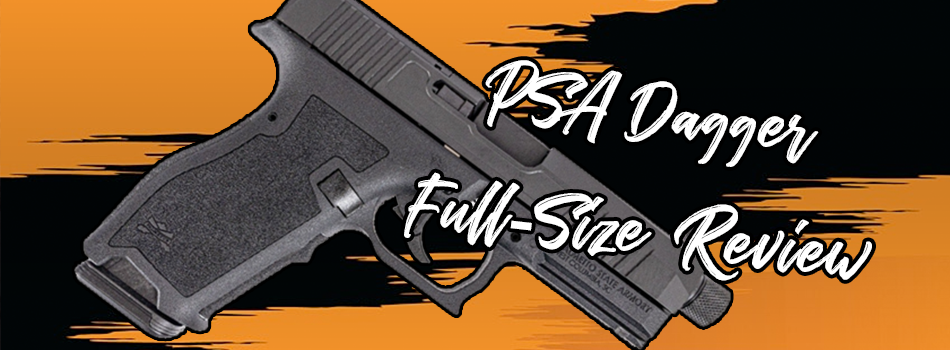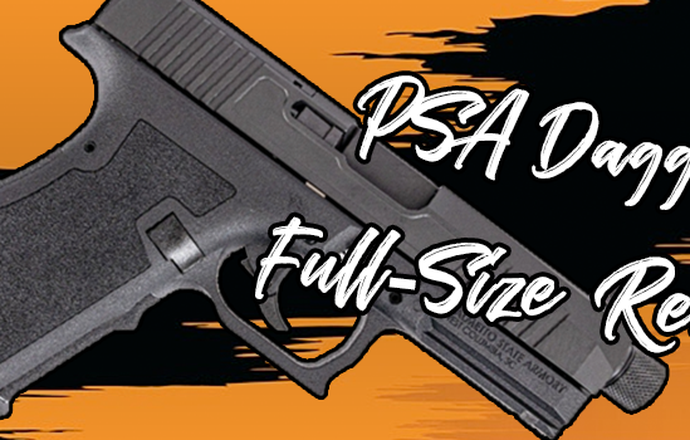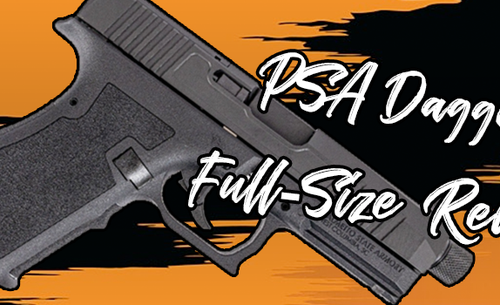


When the request for a PSA Dagger review came across my desk, it piqued my interest, especially considering the price point and how PSA was promoting it. It got me curious about its other possible merits and whether or not it would live up to the hype.
When you’re dealing with any Glock clone - which the PSA Dagger definitely is - the question becomes whether to opt for this budget-friendly Glock or even consider a Glock-esque alternative when you can go out and spend some more money on the real thing.
Glock owners like myself are loyal and reluctant to look elsewhere. But my raison d’etre as a munitions blogger is to help you make an informed decision, and, spoiler alert, I really like this pistol.
Let me show you why. I’ll delve into the specs of the Palmetto State Armory Dagger full-size pistol, a Glock-inspired firearm with resemblances to both the Glock 17 and Glock 19, and go over why the PSA Dagger is reliable and worth considering, especially if you’re just getting into firearms or handguns.
PSA DAGGER REVIEW: SPECS
This striker-fired 9mm pistol boasts a tastefully milled slide, ready to accommodate optics with an RMR footprint. Weighing in at a mere 22.5 ounces unloaded, the pistol stretches slightly over seven inches in overall length—a nice overall size and weight. Its stainless steel barrel embraces a sleek DLC Black coating, mirroring the slide's stainless steel construction, which also flaunts a black DLC coating. The frame, made of polymer, attaches to the slide in a typical Glock fashion.
Notable differentiators of the frame include an adjusted grip angle that fits palms more comfortably than traditional Glock pistols, along with an enlarged beavertail to safeguard against slide bite.
PSA Dagger S Model
The model I purchased - the "S" model - is furnished with suppressor height sights, catering to the use of suppressors, and the barrel is threaded half by 28 to accommodate various pistol suppressors or muzzle devices.
Departing from the standard Glock trigger found in the 19s and 17s, the Dagger opts for a flat-face trigger. Depending on your preference, that could be a plus or minus, as I’ll show you later in this article.
Main Specs and features of PSA Dagger (Full Size S Model)
Before we break this gun down in a bit more detailed way, let’s take a look at the main PSA Dagger Full Size specs and features;
- Model Name: Palmetto State Armory Dagger Full Size - S
- Caliber: 9mm
- Action: Striker-fired
- Weight (uloaded): 22.5 oz
- Capacity: 17+1
- Overall Width: 1.28"
- Overall Length: 7.15"
- Overall Height: 5.38" (Without Mag)
- Barrel Length: 4.5"
- Barrel Material: Stainless Steel
- Barrel Finish: DLC Coating
- Slide Material: Stainless Steel
- Slide Finish: Black DLC Coating
- Twist Rate: SAAMI Spec 1:10
- Frame Material: Polymer
- Safety: Striker Block Safety & Trigger Safety
- Optics Mount: RMR Pattern
- MSRP: Starts at $299
PSA DAGGER REVIEW: Pros and Cons
My initial impressions: I found the pistol to be quite unremarkable straight out of the box. It basically resembled a Glock, lacking any major distinct features on its own. The only noticeable disparity at first glance was a slightly longer grip due to it being the full-size model, akin to a Glock 17.
Pro: The grip
The most striking difference I noticed after the length was the palm swell on the grip. Unlike the slight hump found on a Glock, it extends more towards the bottom of the grip. Despite my fondness for Glocks, I must admit that their grip design is an aspect I don’t find particularly appealing, and I am not sorry to see it altered for the Dagger
.…and con
However, the texture of the Dagger grip is a bit different from the standard Glock pistols. This Dagger S model lacks the two-finger grooves commonly found on Gen 4 Glocks. Although this change did not greatly impact my final judgment, I think some may find this a little distracting.Also, when I wrap my fingers around it, it tends to pinch my middle and ring fingers, making it somewhat uncomfortable to shoot. (To address this issue, I might end up using a Dremel tool to remove the small nub on the grip.)
Pro: the slide
Comparing the slide of the Dagger S to a Glock 19, I thought of it to be a bit of a hybrid of both Dagger and Glock designs - so far, no surprises here.
Overall, the slide features tasteful serrations on the front and back, ensuring easy racking even with wet hands or gloves. Although it's ported along the front and sides, the barrel remains unported, providing no real functionality other than weight reduction.
Notably, the slide comes with suppressor height sights, a nice feature that caught my attention when I first laid eyes on it.
Con: The magwell
Many shooters I’ve talked to have commented on the peculiar shape of the magwell. And having examined it firsthand now, I think you could call it a flaw.
It is oddly squared off, lacking the ideal bevel angle you would need for the best reloading motion. While I certainly think you can manage to adapt to this flaw, I’d say it was an undesirable feature.
Pro: All hail the beavertail
With my Glocks, I often experience the dreaded slide bite - my thumb falls prey to those hungry slides and ends up getting chewed up. Some might say it's just poor grip, or I’ve just got weird thumbs. Whatever the reason, they have a tendency to roll up next to the slide like they're looking for a snack. Several times I shoot, I end up becoming the main course.
However, I was pleasantly surprised that the Palmetto State Armory dagger didn't give me that issue—and I credit PSA’s addition of a beavertail to the basic Glock design. It was a refreshing change of pace while I was practicing.
Pro: the trigger
During my first range day, the aspect that intrigued me the most was the trigger. I wanted to see how this firearm cycles and ensure its accuracy. The trigger on this gun is quite different from that of a Glock; it gives a sense of resistance, but then there's a slight delay of about 3/16 of an inch before reaching another point of resistance, ultimately leading to the break.
Some people strongly dislike Glock triggers, and at first, I thought this one would embody the least desirable characteristics. However, when you actually shoot with it, you start to overlook these nuances and quickly become accustomed to them.
Surprisingly, despite my anticipation about how this gun would perform, I didn't feel restricted by its trigger at all after a short period of usage.
Pro: recoil management
Though the trigger may not feel exceptional during handling or dry firing, it pleasantly surprised me when it came to recoil management. In terms of shooting experience, it very closely resembles a Glock, with a slightly different grip angle - more vertical compared to the traditional 45-degree cant of a Glock 19 or 17.
Pro: reliability
During the range day, I truly pushed myself to the limits - pedal to the metal - firing approximately 250-300 rounds to start and engaging in various shooting exercises, including movement drills and transitions. I ran various drills, covering a wide range from beginner exercises to full-throttle action.
It was then that I realized the remarkable capabilities of this pistol. During our range day, we experienced only a few malfunctions, which were comparable to the number we encountered while shooting my Glock 19, and I could easily attribute the issue to the ammunition.
Apart from that, there were no accuracy problems, squibs, or any other unusual occurrences with this pistol. It performed flawlessly straight out of the box, which comes as no surprise since it was built on the strong foundation of Glock DNA.
However, I’d be remiss if I didn’t point out that despite firing approximately six to seven hundred rounds so far, that isn’t enough time to determine whether this pistol is durable in the long run. If I get the chance, I’ll post an update later on to let you all know how it worked out.
Pro: the PSA Dagger price
This particular pistol comes in at an MSRP of $369.99, the same price point at which I purchased it. Alongside the pistol, the PSA package includes one 17-round magazine and a soft carry case.
As I was firing this pistol, the real question for me was not whether it was an affordable pistol but if I would feel secure carrying it. Bottom line: I would happily carry this pistol without hesitation.
Many others have suggested to me that - yes, $370 is a great deal, but why not just get a Glock and pay around $589 for the actual name brand? There’s truth in the idea, but I think they’re overlooking a few key points.
To obtain a Glock with the specific configuration I like, plus all the additional serrations and threaded barrel, you would end up having to pay significantly more. It is because of this reason that I believe this pistol fills a necessary niche in the market.
And consider this: saving over two hundred dollars on just the basic firearm means you can afford to purchase a high-end PSA Dagger IWB holster or OWB PSA Dagger holster to enhance the safety and reliability of your new tool.
Frequently Asked Questions about PSA Dagger
Yes, the PSA Dagger is a good gun. It is widely regarded as a top-quality firearm, praised for its reliability, accuracy, and value for money—essentially it’s a Glock Gen 3 clone featuring a polymer frame and a 17-round magazine capacity.
Yes, the PSA Dagger can definitely be regarded as a Glock clone, specifically emulating the attributes of the Glock Gen 3, Glock 19 variation. Drawing inspiration from the very popular Glock 19, the PSA Dagger has slight dimensional discrepancies while maintaining compatibility with most Gen 3 Glock components, including slides and barrels.Interconnectivity with Glock parts and its striking resemblance to its muse has catapulted the PSA Dagger into the spotlight, offering a sought-after and economical alternative to the Glock.
The PSA Dagger is widely regarded as a reliable firearm. Users consistently praise its accuracy and dependability, even considering its affordable price. One test we uncovered reported a flawless performance throughout 1000 rounds of testing, and another fired around 650 rounds without encountering a single malfunction.
While occasional issues have been reported by some users, these instances appear to be rare, and we’ve found that Palmetto State Armory's customer service is, itself, very reliable for promptly addressing any concerns.
The PSA Dagger is proudly manufactured in the United States, crafted by Palmetto State Armory—an American firearms company headquartered in Columbia, South Carolina.
Specifically, the state-of-the-art production facility for the PSA Dagger is situated in Summerville, South Carolina, meticulously built with in-house designed and produced components by Palmetto State Armory, exemplifying excellence in both quality and craftsmanship.
The manufacturer's suggested retail price (MSRP) for the PSA Dagger full-size model starts at $299, making it an affordable alternative to comparable options such as the Glock 19. Keep in mind that the actual price may differ based on the gun's specific features and configurations.
PSA DAGGER REVIEW—CONCLUSION
Despite my initial skepticism towards such designs, I felt right at home with this pistol. Adding a weapon light to the front aided in managing recoil by providing extra weight. Overall, shooting this pistol felt akin to a Gen 3 Glock - it delivered exactly what I expected. And in my opinion, that's precisely what this pistol aimed to achieve.
To be honest, I'll likely continue carrying my Glock 19 - it’s been my trusty sidekick for eight years, and I feel comfortable and familiar with it. The setup is similar to the Dagger, with features like serrations, a DOT suppressor height sight, and other good stuff. But I wouldn’t criticize anyone who was considering switching from their Glock 19 to the Palmetto State Armory Dagger.
The only real downsides I've noticed are the oddly shaped Magwell and the front grip nub. Aside from that, this pistol is truly awesome.
In my opinion, this is one of the best value handguns available on the market today. If you are someone who is in the initial stages of exploring firearms or maybe on a tight budget, then the PSA Dagger should definitely be one handgun to consider. The pistol boasts many great features that make it a fierce competition to the all-time favorite Glock 19, especially when paired up with a proper PSA Dagger holster.
